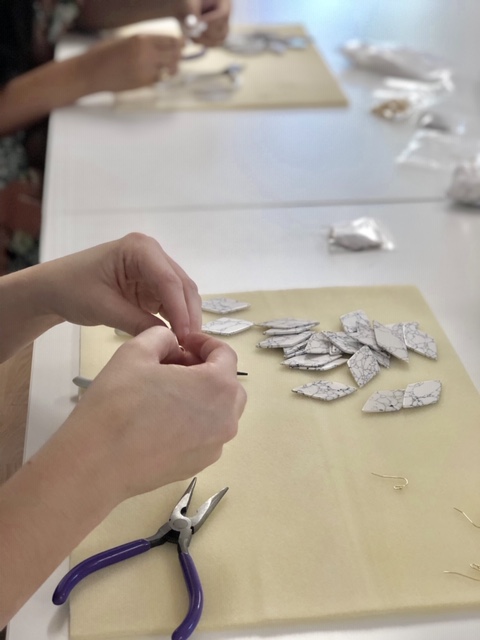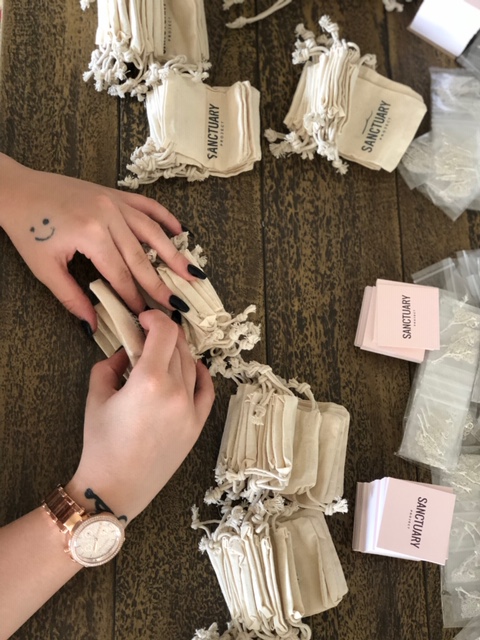As a trafficking survivor herself, Holly Hayes is creating the opportunities she didn’t have.
By Alexis Green, Photos courtesy of Sanctuary Project

Coming out of a life of sex trafficking, Holly Hayes had no idea where to turn. She had no experience holding a job outside of sex work, and the world of legal employment seemed foreign to her.
“I needed to learn how to survive in a world that I had no skills to survive in,” Hayes says. “I had a criminal record. I had been homeless. And my trafficker had really beat my self-esteem down to the point that I had no value other than what a man would pay for me.”
On the path to redefining herself, Hayes landed a job in a humble yet legitimate trade: shoe shining. Cleaning shoes gave Hayes a sense of purpose and comfort. But it was not just the job that uplifted her; her co-workers, also sex-trafficking survivors, bolstered her.
“I was in a community with other survivors, so my story started to become less…scary to me,” Hayes says. “I felt less afraid to face the world because I was around all these other people who are facing the world too. We were all doing it together.”
Hayes continued working with various organizations that helped women transitioning from a life of trauma. While she loved the community work, Hayes had bigger dreams, ones of creating a jewelry line that exhibited her love for European minimalism. With her passion for uplifting women and her eye for design, Hayes created Sanctuary Project, a nonprofit social enterprise that sells handmade jewelry, the proceeds from which fund job opportunities and training for survivors of trafficking, addiction and violence.
“I have a unique lens to this and am able to mentor women because I’ve walked through it,” Hayes says. “I’m not just some do-gooder coming at them like, ‘I’m going to help you or save you.’ I wish somebody had walked with me and did this.”
By offering employees short shifts and $10 an hour, the project provides women with the chance to heal at their own pace. Part of Hayes’ overall goal is to show survivors they are limitless and that past traumas do not define them.
“It helps build their self-esteem,” Hayes says. “A lot of times, they felt like they had no worth coming out of [trafficking], or it only came from their sexuality. We’re able to say, ‘No, you’re a valuable asset.’”
Through Sanctuary Project, women can build resumes and the confidence necessary to find permanent jobs, though Hayes admits it’s somewhat bittersweet to lose them as employees. She says it’s sad watching them leave but is happy to help build “them up to the point where they feel safe to fly the coop.”
Rebuilding a sense of self-worth comes from more than just an hourly wage. It comes from a sense of community. For the women of Sanctuary Project, that comes in the form of a charming white house in East Austin that’s adorned in stained-glass windows. Upstairs, they sit together during work shifts, sharing laughter and stories while crafting jewelry pieces.
Creating a sense of home is what drew Hayes to this location, which will also open as a retail space early next year. Offering free beverages and treats, Hayes also wants the store to act as a refuge for people in need.
“We want to be a beacon in this neighborhood and to be a place where people really feel they’re welcome,” Hayes says. “This is a home for everyone to come make beautiful things, look at beautiful things and buy beautiful things.”
Sanctuary Project jewelry, which ranges in price from $22 to about $60, features statement pieces like dainty branch earrings and necklaces, as well as stunning marble pendants.
The designs are an ode to Hayes’ time spent in Paris and inspired, fittingly, by the idea of sanctuary. Her affinity for the theme came from a powerful scene in the Hunchback of Notre Dame in which the friendless Quasimodo yells, “Sanctuary!” upon saving a girl from execution and retreating to the cathedral.
“I think we’re all the hunchback in some way, and we’ve all been hurt by the world, especially as survivors of trafficking and…addiction,” Hayes says. “I wanted to create a place that had that feeling of a sanctuary. Once you cross this line, you can’t be touched. You get to cry sanctuary like the hunchback. You’re safe here.”



